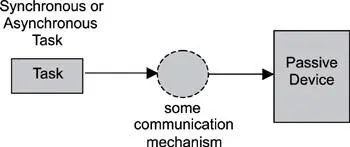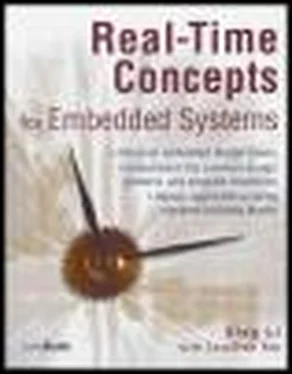Recommendation 2: Combine tasks for I/O devices that generate infrequent interrupts having long deadlines.In the initial design, each active I/O device can have a separate task assigned to handle processing. Sometimes, however, combining the processing of two I/O devices into a single task makes sense. For example, if two I/O devices generate aperiodic or asynchronous interrupts infrequently and have relatively long deadlines, a single task might suffice.
Recommendation 3: Assign separate tasks to devices that have different input and output rates.Generally speaking, a task that handles a device with a high I/O frequency should have a higher task priority than a task that handles a device with a lower frequency. Higher I/O frequency implies shorter, allowable processing time. However, the importance of the I/O operation, and the consequences of delayed I/O, should be taken into account when assigning task priorities with respect to I/O frequency.
Recommendation 4: Assign higher priorities to tasks associated with interrupt-generating devices.A task that needs to interface with a particular I/O device must be set to a high-enough priority level so that the task can keep up with the device. This requirement exists because the task's execution speed is usually constrained by the speed of the interrupts that an associated I/O device generates and not necessarily the processor on which the application is running.
For I/O devices that generate periodic interrupts, the interrupt period dictates how long a task must handle processing. If the period is very short, tasks associated with these devices need to be set at high priorities.
For I/O devices that generate aperiodic interrupts, it can be difficult to predict how long an associated task will have to process the request before the next interrupt comes in. In some cases, interrupts can occur rapidly. In other cases, however, the interrupts can occur with longer time intervals between them. A rule of thumb is that these types of tasks need their priorities set high to ensure that all interrupt requests can be handled, including ones that occur within short time intervals. If an associated task's priority is set too low, the task might not be able to execute fast enough to meet the hardware device's needs.
Recommendation 5: Assign a resource control task for controlling access to I/O devices.Sometimes multiple tasks need to access a single hardware I/O device. In this case, the device can only serve one task at a time; otherwise, data may be lost or corrupted. An efficient approach is to assign a resource control task to that device (also known as a resource monitor task) . This task can be used to receive multiple I/O requests from different tasks, so that the resource control task can send the I/O requests in a controlled and sequential manner to the I/O device.
This resource control task is not limited to working with just one I/O device. In some cases, one resource task can handle multiple requests that might need to be dispatched to one or more I/O devices.
Recommendation 6: Assign an event dispatch task for I/O device requests that need to be handed off to multiple tasks.Events or requests that come from an I/O device can be propagated across multiple tasks. A single task assigned as an event dispatch task can receive all requests from I/O devices and can dispatch them to the appropriate tasks accordingly.
Guideline 1b: Identify Passive Devices
Passive devices are different from active devices because passive devices do not generate interrupts. They sit passively until an application's task requests them to do something meaningful. Whether the request is for an input or an output, an application's task needs to initiate the event or data transfer sequence. The ways that tasks communicate with these devices is either by polling them in a periodic manner or by making a request whenever the task needs to perform input or output.
The diagram either for a passive I/O device acting as an input or an output to an application or for communicating with the application periodically or aperiodically is similar to the one illustrated in Figure 14.6.

Figure 14.6: General communication mechanisms for passive I/O devices.
Some typical tasks that can result from identifying a passive I/O device in a real-time application are listed in Table 14.2.
Table 14.2: Common tasks that interface with passive I/O devices.
| Task Type |
Description |
| Aperiodic Passive Device I/O Task |
Assigned to passive I/O devices and issues requests to those devices on an as-needed basis. |
| Periodic Passive Device I/O Task |
Assigned to passive I/O devices and polls those devices in a periodic fashion. |
| Resource Control Device I/O Task |
Assigned for controlling the access to a shared hardware I/O device or a group of devices. |
| Event Dispatch Device I/O Task |
Assigned for dispatching events to other tasks from one or more I/O devices. |
Recommendation 1: Assign a single task to interface with passive I/O devices when communication with such devices is aperiodic and when deadlines are not urgent.Some applications need to communicate with a passive I/O device aperiodically. This device might be a sensor or display. If the deadlines are relatively long, these requests for one or more passive I/O devices can be handled with one task.
Recommendation 2: Assign separate polling tasks to send periodic requests to passive I/O devices.Commonly, a real-time application might need to sample a signal or some data repeatedly from a passive I/O device. This process can be done effectively in a periodic polling loop. In order to avoid over-sampling or under-sampling the data, assign a separate task to each passive I/O device that needs to be polled at different rates.
Recommendation 3: Trigger polling requests via timer events.More than one way exists to perform timing-based polling loops. One common mistake is using a time delay within the loop that is equal to the period of the sampling rate. This method can be problematic because the loop won't take exactly the same amount of time to execute each time through-the loop is subject to interrupts and preemption from higher priority tasks. A better process is to use a timer to trigger an event after every cycle. A more accurate periodic rate can be maintained using this approach.
Recommendation 4: Assign a high relative priority to polling tasks with relatively short periods.Tasks that are set up to poll passive I/O devices for inputs may do so at different rates. If the period is very short, less time is available to process incoming data before the next cycle. In this case, these tasks with faster polling loops need to be set with higher priorities. Designers, however, need to remember that this process must be done carefully, as heavy polling can use extra CPU cycles and result in increased overhead.
Guideline 2: Identify Event Dependencies
Events in a real-time application can propagate across multiple tasks. Whether an event is generated externally from an I/O device or internally from within the application, a need exists for creating a task or a group of tasks that can properly handle the event as it is propagated through the application. Externally generated events are discussed in the pervious sections, so the focus here is on internally generated events. Examples of events that can be generated internally to an application include when error conditions arise or faults are detected. An event in this case is generated and propagated outward to an I/O device or an internal corrective action is taken.
Читать дальше













